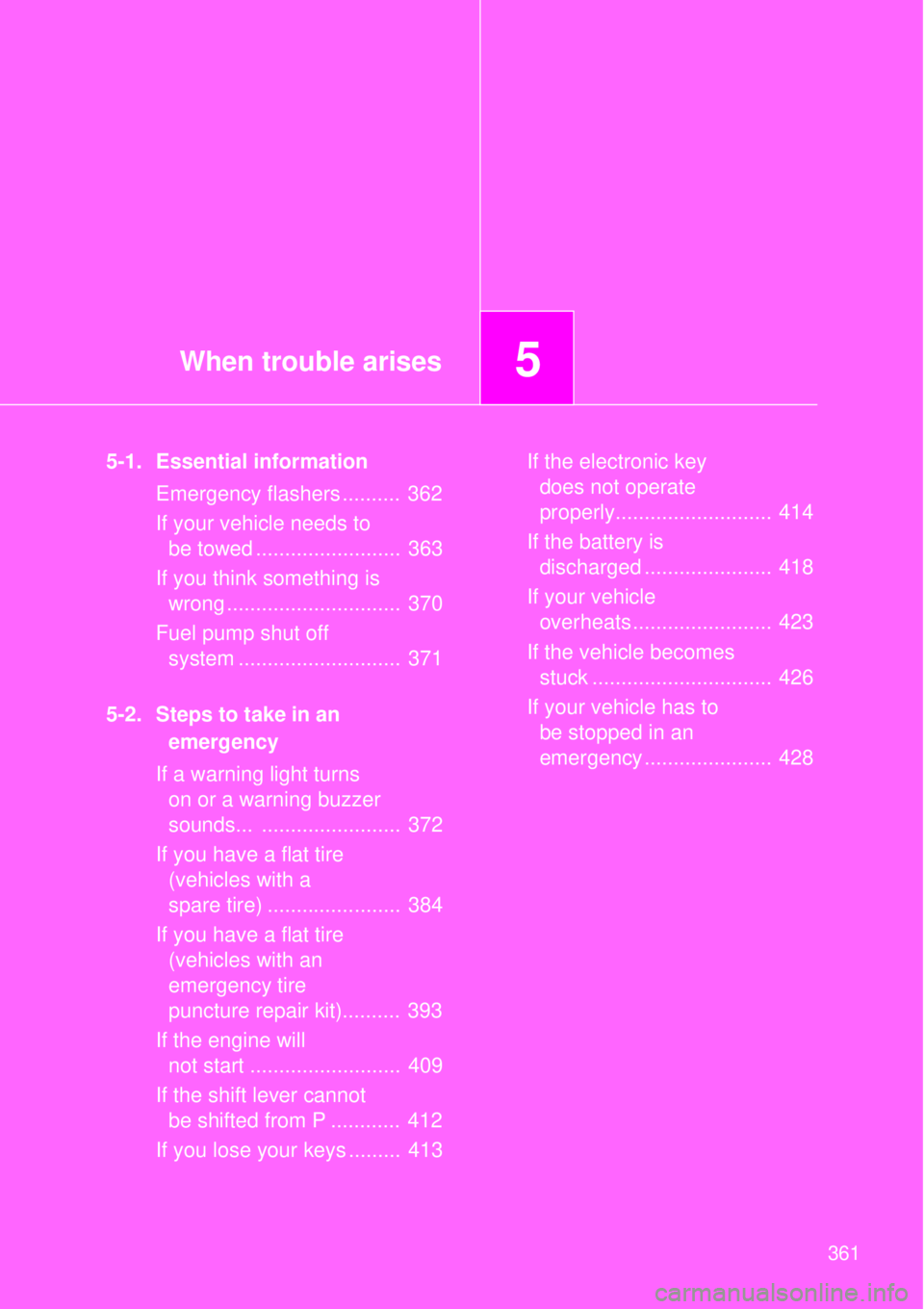Page 361 of 464

5When trouble arises
361
5-1. Essential information
Emergency flashers .......... 362
If your vehicle needs to
be towed ......................... 363
If you think something is
wrong .............................. 370
Fuel pump shut off
system ............................ 371
5-2. Steps to take in an
emergency
If a warning light turns
on or a warning buzzer
sounds... ........................ 372
If you have a flat tire
(vehicles with a
spare tire) ....................... 384
If you have a flat tire
(vehicles with an
emergency tire
puncture repair kit).......... 393
If the engine will
not start .......................... 409
If the shift lever cannot
be shifted from P ............ 412
If you lose your keys ......... 413If the electronic key
does not operate
properly........................... 414
If the battery is
discharged ...................... 418
If your vehicle
overheats ........................ 423
If the vehicle becomes
stuck ............................... 426
If your vehicle has to
be stopped in an
emergency ...................... 428
Page 370 of 464
370
5-1. Essential information
If you think something is wrong
If you notice any of the following symptoms, your vehicle probably
needs adjustment or repair. Contact any authorized Toyota dealer or
repairer, or another duly qualified and equipped professional as
soon as possible.
Visible symptoms
Fluid leaks under the vehicle
(Water dripping from the air conditioning after use is normal.)
Flat-looking tires or uneven tire wear
Engine coolant temperature gauge needle continually points
higher than normal
Audible symptoms
Changes in exhaust sound
Excessive tire squeal when cornering
Strange noises related to the suspension system
Pinging or other noises related to the engine
Operational symptoms
Engine missing, stumbling or running rough
Appreciable loss of power
Vehicle pulls heavily to one side when braking
Vehicle pulls heavily to one side when driving on a level road
Loss of brake effectiveness, spongy feeling, pedal almost
touches the floor
Page 376 of 464

376 5-2. Steps to take in an emergency
Tire pressure warning
light
When the light comes on:
Low tire inflation pressure
such as
• Natural causes (P. 377)
• Flat tire (P. 384, 393)Adjust the tire inflation pres-
sure (including the spare
tire) to the specified level.
The light will turn off after a
few minutes. In case the
light does not turn off even
if the tire inflation pressure
is adjusted, have the sys-
tem checked by any autho-
rized Toyota dealer or
repairer, or another duly
qualified and equipped pro-
fessional.
When the light comes on
after blinking for 1 minute:
Malfunction in the tire pres-
sure warning system
(P. 378)Have the system checked by
any authorized Toyota
dealer or repairer, or another
duly qualified and equipped
professional.
Automatic transmission
fluid temperature warning
light (if equipped)
Indicates that the auto-
matic transmission fluid
temperature is too high.Stop the vehicle in a safe
place and shift the shift lever
to P.
If the light goes off after a lit-
tle while, the vehicle can be
driven. If the light does not
go off, contact any autho-
rized Toyota dealer or
repairer, or another duly
qualified and equipped pro-
fessional.
Warning lightWarning light/DetailsCorrection procedure
Page 377 of 464

5
377 5-2. Steps to take in an emergency
When trouble arises
*: Driver's and front passenger’s seat belt buzzer:
The driver’s and front passenger’s seat belt buzzer sounds to alert the driver
and front passenger that his or her seat belt is not fastened. The buzzer
sounds for 30 seconds after the vehicle has reached a speed of at least 20
km/h (12 mph). Then, if the seat belt is still unfastened, the buzzer will sound
in a different tone for 90 more seconds.
Front passenger detection sensor and passenger seat belt reminder
and warning buzzer
If luggage is placed on the front passenger seat, the front passenger
detection sensor may cause the warning light to flash and warning
buzzer to sound, even if a passenger is not sitting in the seat.
If a cushion is placed on the seat, the sensor may not detect a passen-
ger, and the warning light may not operate properly.
When the tire pressure warning light comes on
Check the tire inflation pressure and adjust to the appropriate level. Pushing
the tire pressure warning reset switch will not turn off the tire pressure warn-
ing light.
The tire pressure warning light may turn on due to natural causes
The tire pressure warning light may turn on due to natural causes such as
natural air leaks or tire inflation pressure changes caused by temperature. In
this case, adjusting the tire inflation pressure will turn off the warning light
(after a few minutes).
Page 378 of 464

378 5-2. Steps to take in an emergency
If the tire pressure warning system is inoperative
The tire pressure warning system will be disabled in the following conditions:
(When the condition becomes normal, the system will work properly.)
If tires not equipped with tire pressure warning valves and transmitters
are used.
If the ID code on the tire pressure warning valves and transmitters is not
registered in the tire pressure warning computer.
If the tire inflation pressure is 380 kPa (3.87 kgf/cm
2 or bar, 55 psi) or
higher.
The tire pressure warning system may be disabled in the following condi-
tions:
(When the condition becomes normal, the system will work properly.)
If electronic devices or facilities using similar radio wave frequencies are
nearby.
If a radio set at similar frequencies is in use in the vehicle.
If a window tint that affects the radio wave signals is installed.
If there is a lot of snow or ice on the vehicle, in particular around the
wheels or wheel housings.
If non-genuine Toyota wheels are used. (Even if you use Toyota wheels,
the tire pressure warning system may not work properly with some types
of tires.)
If tire chains are used.
If a large metallic object which can interfere with signal reception is put in
the trunk.
If the tire pressure warning light frequently comes on after blinking for
approximately one minute
If the tire pressure warning light frequently comes on after blinking for
approximately one minute when the “ENGINE START STOP” switch is
turned to IGNITION ON mode (vehicles with a smart entry & start system) or
the engine switch is turned to the “ON” position (vehicles without a smart
entry & start system), have it checked by any authorized Toyota dealer or
repairer, or another duly qualified and equipped professional.
Page 379 of 464

5
379 5-2. Steps to take in an emergency
When trouble arises
CAUTION
If the tire pressure warning light comes on
Be sure to observe the following precautions. Failure to do so could cause
loss of vehicle control and result in death or serious injury.
Stop your vehicle in a safe place as soon as possible. Adjust the tire infla-
tion pressure immediately.
If the tire pressure warning light comes on even after tire inflation pressure
adjustment, it is probable that you have a flat tire. Check the tires. If the
tire is flat, change to the spare tire and have the flat tire repaired by the
nearest any authorized Toyota dealer or repairer, or another duly qualified
and equipped professional.
Avoid abrupt maneuvering and braking. If the vehicle tires deteriorate, you
could lose control of the steering wheel or the brakes.
If a blowout or sudden air leakage should occur
The tire pressure warning system may not activate immediately.
NOTICE
To ensure the tire pressure warning system operates properly
Do not install tires with different specifications or makers, as the tire pres-
sure warning system may not operate properly.
Page 384 of 464
384
5-2. Steps to take in an emergency
If you have a flat tire (vehicles with a spare tire)
Your vehicle is equipped with a spare tire. The flat tire can be
replaced with the spare tire.
Before jacking up the vehicle
Stop the vehicle on a hard, flat surface.
Set the parking brake.
Shift the shift lever to P (vehicles with an automatic transmis-
sion) or R (vehicles with a manual transmission).
Stop the engine.
Turn on the emergency flashers.
Location of the spare tire, jack and tools
Jack handle
Spare tire Towing eyelet
Screwdriver JackWheel nut
wrench
Page 385 of 464
5
385 5-2. Steps to take in an emergency
When trouble arises
Taking out the spare tire
Loosen the center fastener that
secures the spare tire.
Replacing a flat tire
Chock the tires.
STEP 1
Flat tireWheel chock
positions
Front
Left-
hand
sideBehind the
rear right-
hand side
tire
Right-
hand
sideBehind the
rear left-
hand side
tire
Rear
Left-
hand
sideIn front of
the front
right-hand
side tire
Right-
hand
sideIn front of
the front
left-hand
side tire